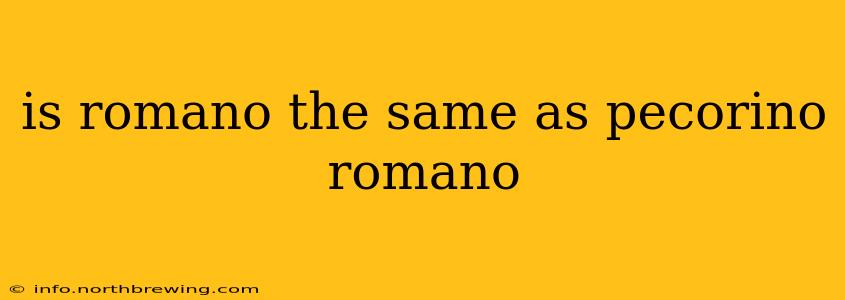The question of whether Romano and Pecorino Romano are the same often sparks confusion among cheese enthusiasts. While they share similarities, understanding their nuanced differences is crucial for making informed choices. This comprehensive guide will delve into the intricacies of these cheeses, addressing common queries and clarifying their distinct identities.
What is Pecorino Romano Cheese?
Pecorino Romano is a hard, sheep's milk cheese originating from Italy. The name itself gives us a clue: "Pecorino" refers to sheep's milk (from the Italian word pecora), and "Romano" signifies its connection to the Roman region. This cheese is known for its characteristically salty, granular texture, and its sharp, sometimes pungent flavor that intensifies with age. Its production is strictly regulated under the Protected Designation of Origin (PDO) rules, ensuring authenticity and quality.
What is Romano Cheese?
"Romano" is a broader term often used to describe a family of hard, salty cheeses. While Pecorino Romano falls under this umbrella, other cheeses made from cow's milk or a blend of milks are also marketed as "Romano." This ambiguity is the root of the confusion. The term "Romano," without the specification "Pecorino," doesn't guarantee the cheese is made solely from sheep's milk, and it's not necessarily produced in Italy adhering to the strict PDO guidelines.
Is All Romano Cheese Pecorino Romano?
No, not all Romano cheese is Pecorino Romano. As explained above, "Romano" is a general term, whereas "Pecorino Romano" designates a specific type of cheese made exclusively from sheep's milk and following specific regulations. Think of it like this: all squares are rectangles, but not all rectangles are squares. Pecorino Romano is a subset of Romano cheeses.
What are the Key Differences Between Pecorino Romano and Other Romano Cheeses?
The primary difference lies in the milk source. Pecorino Romano is made exclusively from sheep's milk, contributing to its unique flavor profile. Other Romano cheeses may utilize cow's milk or a combination of milks, resulting in a milder and potentially less granular texture. Furthermore, Pecorino Romano's PDO status guarantees its production standards, geographical origin, and quality control, which are not guaranteed with other Romano cheeses.
How Can I Tell the Difference When Buying?
Always check the label! Look for "Pecorino Romano" clearly stated. This designation confirms the cheese is made from sheep's milk and adheres to the PDO regulations. If the label simply says "Romano," it doesn't specify the type of milk used or the production standards, leaving room for variations in taste, texture, and quality.
Where Can I Buy Authentic Pecorino Romano Cheese?
Authentic Pecorino Romano is best sourced from reputable specialty cheese shops, Italian delis, or online retailers specializing in Italian food products. These sources are more likely to carry cheeses that meet the PDO standards. Reading reviews and checking certifications can also help you identify trustworthy suppliers.
Are there nutritional differences?
While the precise nutritional values vary slightly depending on the aging process and manufacturer, both Pecorino Romano and other Romano cheeses are generally high in protein and calcium. However, the fat content and specific vitamin and mineral profiles might differ depending on the type of milk used.
In conclusion, while the terms are related, "Romano" and "Pecorino Romano" are not interchangeable. Pecorino Romano is a specific, high-quality cheese with protected designation, while "Romano" encompasses a broader category of cheeses. Understanding this distinction is crucial for choosing the cheese that best suits your taste and culinary needs.
